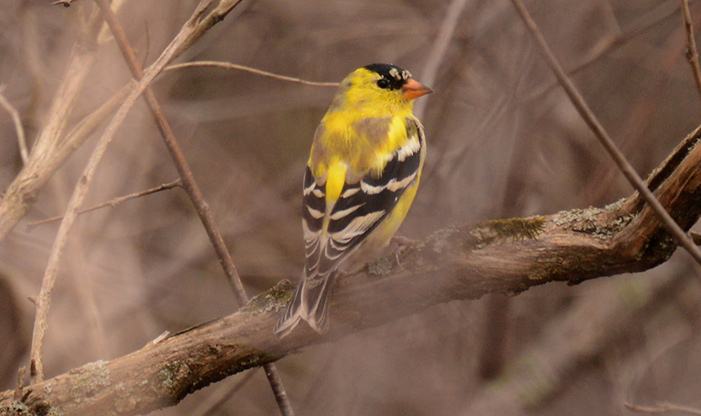This article originally appeared in Spring Panorama 2015.
I never intended to become a birder. How it came to be that I would choose to drive across the state at the rumor of a Northern Hawk Owl sighting, or stand in complete awe of thirty-five American Robins in the woods near my home on a cold January day, is still a bit of a mystery to me. Birds have captivated me, and because of this, I now spend my days looking up.
My rapid immersion was aided by the fact I work here, at Schlitz Audubon. It’s nearly impossible to work at such a beautiful place and not have your curiosity awakened daily. Besides being at Schlitz Audubon, I’ve always felt connected to nature. While at school, I spent Saturdays at Strouds Run, an Ohio State Park in the foothills of the Appalachians. This became my natural sanctuary away from the commotion of college.
Before the spring of 2014, I could name (but not even correctly identify) seven birds: Cardinals, Robins, Crows, Blue Jays, Woodpeckers, Sparrows, and the Ruby-throated Hummingbird. I began to take more hikes with camera in tow, and because it was April, there weren’t too many birds around. I would return with photos of “the regulars” to post to our social media, with no idea what they were. Thank goodness I have patient teachers for co-workers! Don Quintenz and Jean Strelka fielded all of my early birding questions, helping me learn the basics of identification.
Last spring I realized I had never really looked at a Black-capped Chickadee or noticed the bold color of a male American Goldfinch. Walking through the bare April woods and spotting glimpses of color evoked emotions in me I cannot adequately explain. I was enthralled and could not quench my curiosity, so I chose to become an active observer, and this is possible for you as well. I didn’t have steps on how to begin as a birder, so here are some of the things I’ve learned in the last year to help you get started.
Start in Your Own Backyard
Become an active observer in your world. You don’t have to book a trip to Costa Rica—although that DOES sound lovely—to become a birder. You don’t even have to find a wooded area! Start with your own backyard and your neighborhood. Now I can’t even walk to the grocery store or post office without wondering what birds are around. It’s amazing what you see when you begin to pay attention.
Acquire Binoculars
My first pair of binoculars were a $3 garage sale score. I’ve since upgraded to a pair of Nikon Monarchs, but there’s no need to start with a big investment. Before purchasing, visit a store and try several pairs to discover your preferences.
Get a Notebook
I carry my little orange notebook at all times. My first bird observations were messily scrawled across pages. Since I had no clue what I was observing, I recorded as much detail as possible. There are still a lot of birds I do not know, but my notebook is now filled with tallied lists of 4-letter short-hand abbreviations. If you found my notebook and were not a birder, it would look very cryptic. Wood Thrush is abbreviated as WOTH, or the Blackburnian Warbler (one of my favorites) is BLBW. This system is extremely helpful when you’re out in the field. In the time spent writing out an entire name you could miss seeing a warbler!
Buy a Field Guide
Peterson’s Field Guide to Birds of Eastern & Central North America is my go-to reference. The illustrations and descriptions are extremely helpful, especially for new birders. Sometimes just reading the description will help me realize I’m on the wrong path in determining what bird I’m looking at.
Find an Experienced Group of Birders
I would not know nearly as much about birds as I do now if I hadn’t found a special community of birders to learn from. During spring migration there is a group that meets weekly at Schlitz Audubon on Thursdays at 7:00am. They field my constant questions, point out the songs of birds, and gently tell me when I’m actually looking at an American Robin and not a Baltimore Oriole. The wealth of knowledge I’ve absorbed from my new birding friends is unparalleled.
Learn the Songs (Or at Least Try)
This is the main part of birding that I am working on—learning the songs, calls, and chips of birds. Knowing what sounds birds make is a very useful, but difficult to learn, tool to identify them. I use Merlin Bird ID to practice bird songs. The best practice, however, happens out in the field, with an expert birder who can point out songs and quiz you while you’re walking along. (Thanks, Marilyn!)
Birds may not be how you connect with nature, but I’m sure there is something out there for you. Open your eyes and become an active observer wherever you are, because there is new, endless beauty every day—even on a short walk, down a busy street to the post office.


